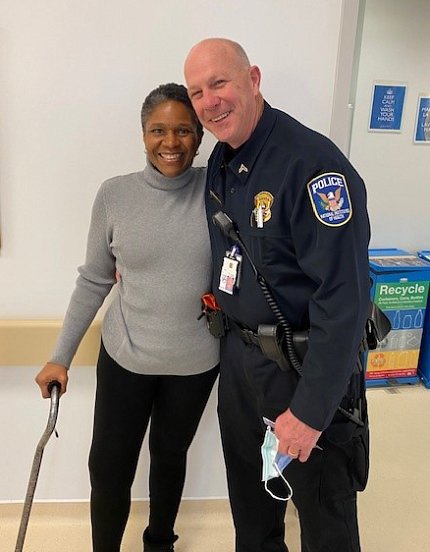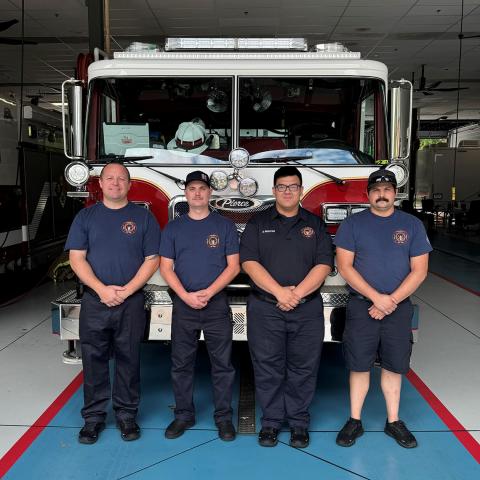National First Responders Day
NIH Honors Fire, Police Departments and Emergency Response Teams

On Oct. 28, NIH recognized the vital contributions of its fire and police departments, emergency communications/911 call center (ECC) and guard staff in honor of National First Responders Day. The event included celebratory meals and a heartfelt message from NIH leadership, underscoring the agency’s gratitude for the unwavering service of these essential personnel.
First responders at NIH work around the clock—365 days a year—providing life-saving emergency care and maintaining the safety of the community. As President Joe Biden noted in his 2022 proclamation on National First Responders Day: “Today and every day, America’s first responders remain on alert and on call, always there for us when we need them... Let us renew our commitment as a nation to standing by them and their families just as they stand by us, shaping a stronger, safer and more resilient America.”
NIH, with its sprawling 300+ acre main campus and more than 75 buildings, relies heavily on a robust emergency support community to protect approximately 25,000 daily visitors and staff. Each division within NIH’s emergency services plays a critical role in safeguarding the campus and its people.
The ECC serves as NIH’s 911 call center, handling all emergency calls from the NIH community. ECC personnel direct appropriate resources to incidents swiftly and efficiently. The team ensures that help is only a phone call away for anyone experiencing an emergency on campus.
NIH’s Division of Police works tirelessly to secure the safety of the community, its facilities and property. With a team of experienced officers, including trained K-9 units, the division manages campus security and runs the Commercial Vehicle Inspection Center, which inspects vehicles entering the premises.
This year, the NIH Police placed an increased emphasis on traffic safety following concerning roadway incidents on campus. They play leading roles on the NIH roadway safety working group, an NIH-wide team dedicated to enhancing the safety and vigilance of everyone who comes to NIH’s campuses. These days, officers are regularly stationed at key intersections during rush hours to promote awareness and safety for drivers, cyclists and pedestrians.
The department also prioritizes empathy and compassion, qualities especially appreciated by a patient visitor earlier this year. When this visitor needed assistance walking from the Children’s Inn at NIH to the Clinical Center due to mobility issues, Officer Daniel Sugrue came to her assistance by loading all of her items into his police vehicle, driving her and her family to the entrance, and then walking them to their appointment. She never caught the name of the officer that stepped up that day, but through subsequent visits for her child’s care, she was eventually able to identify Sugrue and express her gratitude.

The NIH Fire Department is also known for going above and beyond their scope of duty to ensure safety. In July, select staff were undergoing drivers training in the Silver Spring area, when they were flagged down by a large group of bystanders reporting that a pedestrian was struck by a vehicle traveling at high speed.
Without hesitation, the crew reacted to the incident. Captain Steven Stauffer had been performing the drivers training, with Technician Daniel Hill as the unit officer. Hill radioed Montgomery County Fire and Rescue Service (MCFRS) while Technician Danny Nguyen and Master Firefighter Walter Wright attended to the injured patient. Patient care was transferred to MCFRS as soon as they arrived on scene for advanced life support.
Fire Chief Stephen Teagarden writes of his team, “In a situation where every second counted, the crew demonstrated remarkable composure to remain calm amidst chaos, coordinate effectively under extreme stress, and deliver lifesaving interventions. These actions exemplify our commitment to the well-being of those we serve. Each member’s role in this challenging situation—whether in direct medical care, managing the large crowd and providing scene safety – stands as a testament to our training.”
For more than 70 years, the NIH Fire Department has responded to emergencies across campus facilities, including biosafety level-3 labs and residential housing. The department has mutual aid agreements with nearby Walter Reed National Military Medical Center and Montgomery County Fire and Rescue, responding to emergencies in the surrounding area. They also play a pivotal role in national health crises, such as transporting patients with Ebola to NIH in specialized ambulances during the 2014 outbreak.
As NIH’s first responders continue to serve under all circumstances—whether during a pandemic, severe weather or budget shortfalls—this year’s National First Responders Day was a reminder of their crucial role. NIH encourages all staff to program the NIH emergency number, (301) 496-9911, into their phones to ensure fast assistance in case of an emergency on campus.
A special thanks goes to this year’s First Responders appreciation working group and representatives Captain Danny McMahon at the NIH Fire Department and Sergeant Matt Mehlhaff of the NIH Police for organizing these celebrations on the Bethesda campus.
